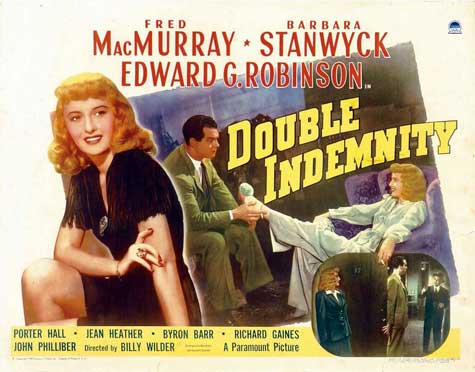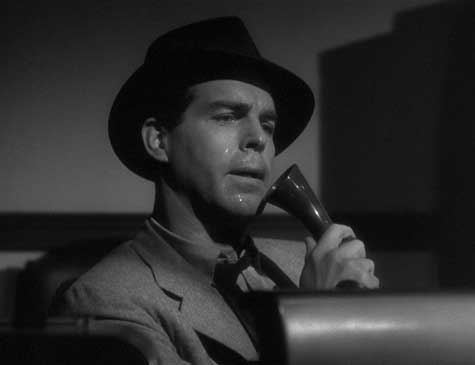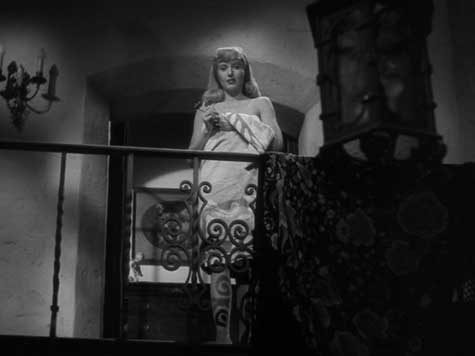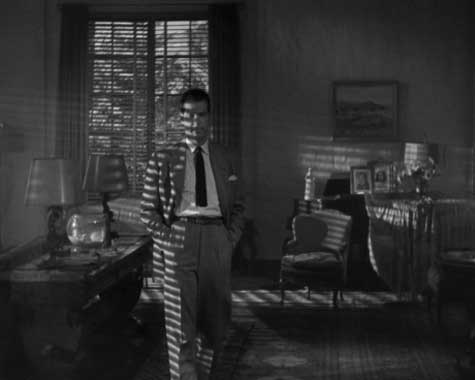
This year film noir turns 70. While there had been some intermittent films leading up to the birth of the classic noir, in 1944 the dahlia bloomed with six key films: Double Indemnity, Laura, Murder My Sweet, Phantom Lady, When Strangers Marry, and The Woman In the Window. In these films you have many of the key figures in noir making some of their first forays into the genre (directors Billy Wilder, Otto Preminger, Fritz Lang, and Robert Siodmak; writers Raymond Chandler, Cornell Woolrich, Vera Caspary, Phillip Yordan; actors Robert Mitchum, Barbara Stanwyck, Joan Bennett, Dana Andrews—just to name a few). This onslaught of darkness came in the wake of the bleakest days (from the American perspective, anyway) of WWII. The basis of many of these films were older properties but it is the way these films came out—physically darker, psychologically denser, and ultimately more pessimistic—that marks the real birth of film noir. This post kicks off a new series which will explore these six landmark films.
Double Indemnity might well be the most famous of all film noirs, and there are good reasons for its outsized reputation. It is a hugely entertaining film of great technical accomplishment—and if that sounds like mannered praise, it’s because I’ve never really fallen in love with this movie.

It tells the story of an insurance agent named Walter Neff. As the movie begins, he stumbles into his company’s office building in the middle of the night and heads to the office of his claims manager, Barton Keyes. He takes out Keyes’s Dictaphone and begins to confess to a murder. This leads to a flashback structure in which we see hotshot salesman Neff pay a visit to the Dietrichson house. Mr. Dietrichson isn’t home, but Mrs. Dietrichson is there wearing only a towel and an anklet. Before long, Neff and Mrs. Dietrichson are trading barbs and sharing drinks, and the young housewife starts talking to the insurance man about maybe getting her much older husband some life insurance. It doesn’t take long for Neff to see where this is going, but he’s already hooked on Mrs. Dietrichson. A few clandestine meetings later, Neff has engineered the perfect murder. He and Mrs. Dietrichson kill her husband, make it look like an accident, and sit back while the cops fall for it. Now all they have to worry about is the scrappy little claims manager Mr. Keyes.
The making of Double Indemnity—particularly the writing of the script—is the stuff of movie legend. Adapted from the novel by James M. Cain, the screenplay was written by director Billy Wilder and novelist Raymond Chandler. This was an impossibly talented duo, though not exactly the match made in heaven that it might have looked like on paper. Chandler was curmudgeonly under the best of circumstances, and he neither approved of Cain’s book (“Everything Cain touches smells like a billygoat”) nor enjoyed working with Wilder (“an agonizing experience”). Perhaps those fat studio paychecks gave him the strength to endure.

The script produced by the two men, however, is a classic of noir screenwriting. The banter between Neff and Mrs. Dietrichson is as crisp, and artificial, as a new three-dollar bill. Like this from their first meeting:
Mrs. Dietrichson: I wonder if I know what you mean.
Neff: I wonder if you wonder.
And this toward the end of the film:
Mrs. Dietrichson: We’re both rotten.
Neff: Only you’re a little more rotten.
My favorite bit is this tossed off exchange between Mr. Norton, the head of the insurance company, and Keyes, the claims manager:
Norton: The witness from the train, what was his name?
Keyes: His name was Jackson. Probably still is.
Double Indemnity was justly famous at the time for the wit and snap of these lines, and more than any other single movie, this one laid a lot of groundwork for how people talk to each other in a film noir. It wasn’t all wisecracks, though. Wilder and Chandler also worked in haunting passages that presaged the doom-obsessed denizens of dark city who would follow in their wake.
Neff: As I was walking down the street to the drugstore, suddenly it came over me that everything could go wrong…I couldn’t hear my own footsteps. It was the walk of a dead man.
As good as all this is, however, the script remains a curious combination of Cain’s gritty realism and Chandler’s rather Victorian sensibilities. Like Cain’s The Postman Always Rings Twice, Double Indemnity broke new ground in terms of its lurid subject matter. Simply put, in the thirties and early forties most movies were not about the claustrophobic psyches of murderers. Cain had based his characters on Ruth Snyder and Judd Gray, a real life duo who murdered Snyder’s husband and tried to collect on a forged insurance policy, yet the film version is hardly an attempt at realism in any sense we would understand the term today. Of course, today pornography and the news have rendered sex and violence in enough clinical detail that no mystery exists for film to exploit, but in 1944, most everything had to be done through coded language—language tame enough for Sunday school teachers. Even then it could get you into trouble.
Like so much noir, Double Indemnity, benefits from the tension resulting from the pull of opposites. Holding it altogether was the personality of Billy Wilder, Hollywood’s reining misanthrope and the quickest wit in town. Wilder kept what he wanted from Cain’s novel, extracted gold from Chandler and, together with his director of photography, John Seitz, gave the film a lush visual style that nevertheless captured the tawdriness of the story. Venetian blinds had appeared in movies before this one, but in Double Indemnity the lazy daylight shifts through the blinds in the middle of the day and corrupts a normal house into something sinister. The Dietrichson home is like a cave with sunlight seeping through. (Wilder and Seitz would use the same look in Sunset Blvd—shorthand for the dark underbelly of California.) Other times, as in the scenes set in Jerry’s supermarket, the lighting is harsh and flat. Neff and Mrs. Dietrichson wander the aisles of cheap, neatly stacked merchandise—the embodiment of California’s wartime image as the land of plenty—and plan a murder. American society never had a more cheerfully vicious critic in Hollywood than Billy Wilder. His image of the banality of evil, of a murder hatched on the baby food aisle, had its fullest expression here.

Walter Neff and Mrs. Dietrichson, played by Fred MacMurray and Barbara Stanwyck, would become the archetypal antihero and femme fatale, but a lamentable inclination toward honesty forces me to admit that they are not my favorite screen couple. MacMurray does a capable job as Neff, playing him with a Dick Powell-like smugness, but I can’t help myself—I wish Powell would have played the role. (To see MacMurry at his noir best, by the way, see him in the underrated Pushover with Kim Novak.)
Here’s the larger (and, I’m sure, more unforgivable) heresy: I’m just not a huge Stanwyck fan. As much as I like her, I’ve never loved her. For more than a few people, though, she is the Queen of noir. Here is what is inarguable: with Double Indemnity, Stanwyck forged the image of the femme fatale and set the standard by which all others are measured. So why my reserve? Something about her leaves me cold. To put it bluntly, Stanwyck doesn’t turn me on. I’ve watched many a femme fatale lead many a befuddled man to his doom, and I’ve found that for the story to really work on me I have to identify with the antihero’s lust and longing. I can understand killing for Jane Greer. Or Lizabeth Scott. Or Audrey Totter. I just don’t think I’d kill for Barbara Stanwyck. It doesn’t help that in this film she’s wearing a wig that makes her look, in the words of one studio executive at the time, “like George Washington.” But it’s more than the wig. Stanwyck lacks warmth. I know she’s supposed to be a cold-blooded killer; I just don’t understand why someone would be drawn to her in the first place—where’s the heat that sparks the flame? In her screwball comedies for Capra and Sturges, she had a tomboyish charm that, for my money, was far more appealing. (My favorite Stanwyck is the Stanwyck of Ball Of Fire.) In so many of her noirs, though, her charisma fails to work on me.
It’s okay if I say that I like, rather than love, Double Indemnity. It doesn’t need me to love it. It’s a giant of film noir. Hell, for a lot of people, it is the giant of film noir. Timing is everything, and Wilder/MacMurray/Stanwyck got to the party first. With this film, they created the prototypical femme fatale story.
Jake Hinkson, The Night Editor, is the author of The Posthumous Man and Saint Homicide.
Read all posts by Jake Hinkson for Criminal Element.

PS. Here’s a link to [url=https://www.youtube.com/watch?v=vN9THMXxndw]Raymond Chandler’s little cameo[/url] in the film. Funny enough, this has been hiding in plain sight for decades.
Chandler even makes a cameo in the film:
[img]http://latimesblogs.latimes.com/.a/6a00d8341c630a53ef0115720a412b970b-pi[/img]
http://youtu.be/vN9THMXxndw
I didn’t miss Dick Powell in this film. Granted, I thought he was great as Philip Marlowe in “Murder My Sweet”. But I was so impressed by Fred MacMurray in this film that I didn’t miss Powell.